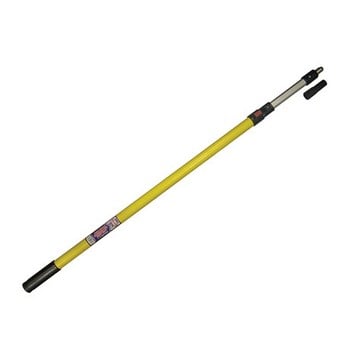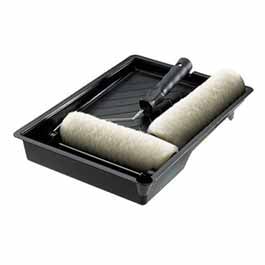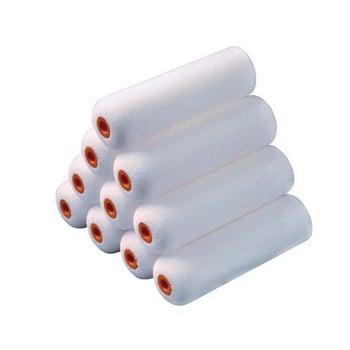Paint Rollers, Refills & Frames
Find out more about Paint Rollers, Refills & Frames
Paint rollers, refills, and frames are essential tools in the world of painting, particularly for larger surfaces like walls and ceilings. Each component plays a crucial role in achieving a smooth and even finish, and understanding their features can greatly enhance your painting experience.
Paint Rollers: A paint roller is a cylindrical tool covered in a fabric, foam, or other material that holds and applies paint. Rollers come in various sizes, typically ranging from 4 to 18 inches in width. The choice of roller size depends on the area being painted; larger rollers are efficient for covering broad surfaces quickly, while smaller ones are ideal for tight spaces and detailed work. The roller cover material is also important:
- Napped rollers have a textured surface that holds more paint, making them suitable for rough surfaces like stucco or textured walls.
- Smooth rollers are designed for flat surfaces and provide a finer finish, ideal for drywall or smooth plaster.
Refills: Refills refer to the replacement roller covers that can be easily swapped out when they wear out or become clogged with paint. Roller covers are available in various materials and nap lengths, which affect the finish and texture of the paint application. For example, a longer nap is better for textured surfaces, while a shorter nap is ideal for smooth finishes. Choosing the right refill is essential for achieving the desired look and ensuring efficient paint application.
Frames: The roller frame is the handle and structure that holds the roller cover in place. Frames come in various styles, including standard frames for manual use and extendable frames that allow for reaching high ceilings or difficult areas without the need for a ladder. The frame should be sturdy and comfortable to hold, as this will affect your control and ease of use while painting. Some frames also feature a quick-release mechanism for easy roller cover changes.
When using paint rollers, it's important to load the roller properly, ensuring even coverage without over-saturating it. Techniques such as rolling in a "W" pattern can help distribute paint evenly and minimise streaks. Overall, understanding the components of paint rollers, including the rollers themselves, their refills, and the frames, can significantly impact the efficiency and quality of your painting projects.
Paint Rollers, Refills & Frames FAQs
What type of paint roller should I use for my project?
Choosing the right type of paint roller for your project is crucial for achieving a smooth and professional finish. The type of roller you select largely depends on the surface you are painting and the type of paint you are using. Here’s a detailed guide to help you make the best choice.
First, consider the nap length of the roller cover. The nap refers to the thickness of the fibres on the roller. For smooth surfaces such as drywall or plaster, a roller with a short nap (1/4 to 3/8 inch) is ideal. This type of roller will apply paint evenly and minimise texture. If you're working on semi-smooth surfaces like lightly textured walls, a medium nap (3/8 to 1/2 inch) can help fill in the minor imperfections while still providing a smooth finish.
For rough or textured surfaces such as stucco, brick, or concrete, you'll want to opt for a roller with a longer nap (3/4 inch or more). These longer fibres can reach into the crevices and provide better coverage, ensuring that the paint adheres well to the uneven surface.
Next, think about the material of the roller cover. Common materials include polyester, microfiber, and foam. Polyester covers are versatile and work well with water-based paints. Microfiber rollers are excellent for smooth finishes because they hold more paint and provide a finer texture. Foam rollers are great for applying varnishes or gloss paints, especially on smooth surfaces, as they leave a very smooth finish without lint.
Additionally, consider the size of the roller. Standard rollers are typically 9 inches wide, which is suitable for most wall applications. However, if you're painting smaller areas, like trim or furniture, a smaller roller (4 inches) might be more effective. For high ceilings, using a roller with an extension pole can help you reach those areas without the need for a ladder.
Lastly, think about the type of paint you are using. If you’re working with oil-based paints, ensure that your roller cover is compatible, as some materials may not perform well with oil-based products. Always check the label on the roller cover for compatibility with the type of paint you plan to use.
In summary, when selecting a paint roller, consider the surface texture, nap length, cover material, size, and type of paint. By matching these factors to your specific project, you can ensure a more efficient painting process and a high-quality finish.
How do I choose the right roller cover material?
Choosing the right roller cover material is essential for achieving the best results in your painting project. The material of the roller cover affects how well the paint is applied, how much paint is absorbed, and the finish you will ultimately achieve. Here’s a detailed look at the different types of roller cover materials and how to select the right one for your needs.
First, let’s explore napped roller covers, which are commonly made from materials like polyester, lambswool, or a blend of fibres. Polyester covers are versatile and suitable for a variety of surfaces. They work well with water-based paints and provide a smooth finish on flat or semi-smooth surfaces. If you're painting a textured surface, a polyester roller with a longer nap can help reach into the crevices.
Lambswool roller covers are excellent for rough surfaces, such as stucco or brick. They hold a significant amount of paint and provide good coverage, making them ideal for larger areas. However, lambswool can be more expensive and may require more maintenance than synthetic options.
Next, there are microfiber roller covers, which are made from a blend of polyester and nylon. These covers are known for their ability to hold more paint and provide a finer finish. Microfiber is particularly effective for smooth surfaces, as it reduces the likelihood of leaving lint or roller marks. If you're aiming for a professional look on walls or ceilings, microfiber is a great choice.
Foam roller covers are another option, especially for applying glossy paints, varnishes, or stains. Foam rollers provide a very smooth finish and are less likely to leave texture. They are best suited for flat surfaces, such as furniture or cabinets. However, foam rollers may not hold as much paint as napped rollers, so they might require more frequent dipping.
When selecting the roller cover material, consider the type of paint you will be using. For water-based paints, polyester and microfiber are excellent choices, while oil-based paints may work better with lambswool or certain synthetic blends. Always check the label on the roller cover to ensure compatibility with your paint type.
Additionally, think about the surface you are painting. For smooth surfaces, a short-nap polyester or microfiber cover will give you a clean finish. For textured surfaces, opt for a longer nap to ensure even coverage.
In summary, when choosing the right roller cover material, consider the type of surface you’re painting, the finish you want to achieve, and the type of paint you’ll be using. By aligning these factors with the right material, you can enhance your painting experience and achieve the best possible results.




Shop our wide range of Paint Rollers, Refills & Frames at Trading Depot. Achieve a flawless finish with our premium paint rollers, refills, and frames, perfect for smooth and textured surfaces. Designed for DIYers and professionals, our selection includes microfibre, foam, and woven rollers for even paint application with minimal splatter. Choose from replacement roller refills for extended use and durable roller frames for a comfortable grip and control. Ideal for walls, ceilings, and large surfaces, our rollers work with emulsion, gloss, and masonry paints.